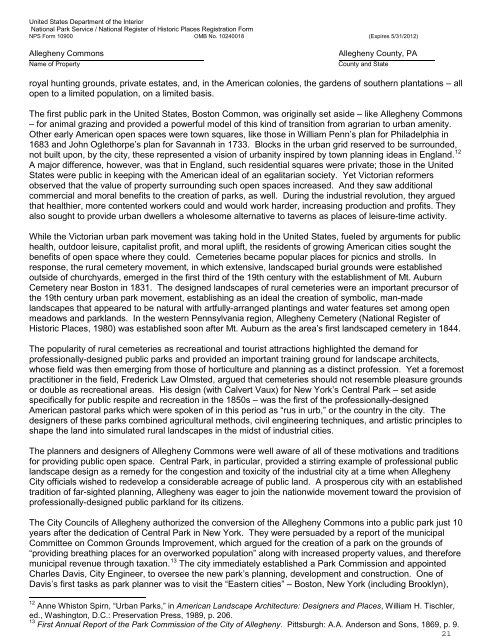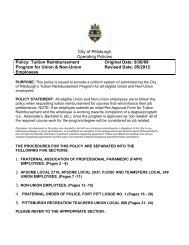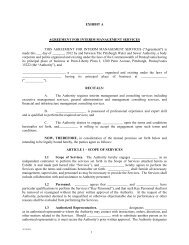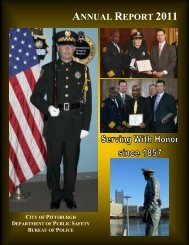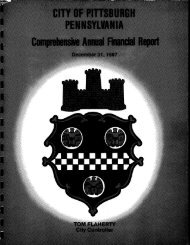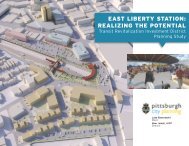Allegheny Commons - City of Pittsburgh
Allegheny Commons - City of Pittsburgh
Allegheny Commons - City of Pittsburgh
Create successful ePaper yourself
Turn your PDF publications into a flip-book with our unique Google optimized e-Paper software.
United States Department <strong>of</strong> the InteriorNational Park Service / National Register <strong>of</strong> Historic Places Registration FormNPS Form 10900 OMB No. 10240018 (Expires 5/31/2012)<strong>Allegheny</strong> <strong>Commons</strong>Name <strong>of</strong> Property<strong>Allegheny</strong> County, PACounty and Stateroyal hunting grounds, private estates, and, in the American colonies, the gardens <strong>of</strong> southern plantations – allopen to a limited population, on a limited basis.The first public park in the United States, Boston Common, was originally set aside – like <strong>Allegheny</strong> <strong>Commons</strong>– for animal grazing and provided a powerful model <strong>of</strong> this kind <strong>of</strong> transition from agrarian to urban amenity.Other early American open spaces were town squares, like those in William Penn’s plan for Philadelphia in1683 and John Oglethorpe’s plan for Savannah in 1733. Blocks in the urban grid reserved to be surrounded,not built upon, by the city, these represented a vision <strong>of</strong> urbanity inspired by town planning ideas in England. 12A major difference, however, was that in England, such residential squares were private; those in the UnitedStates were public in keeping with the American ideal <strong>of</strong> an egalitarian society. Yet Victorian reformersobserved that the value <strong>of</strong> property surrounding such open spaces increased. And they saw additionalcommercial and moral benefits to the creation <strong>of</strong> parks, as well. During the industrial revolution, they arguedthat healthier, more contented workers could and would work harder, increasing production and pr<strong>of</strong>its. Theyalso sought to provide urban dwellers a wholesome alternative to taverns as places <strong>of</strong> leisure-time activity.While the Victorian urban park movement was taking hold in the United States, fueled by arguments for publichealth, outdoor leisure, capitalist pr<strong>of</strong>it, and moral uplift, the residents <strong>of</strong> growing American cities sought thebenefits <strong>of</strong> open space where they could. Cemeteries became popular places for picnics and strolls. Inresponse, the rural cemetery movement, in which extensive, landscaped burial grounds were establishedoutside <strong>of</strong> churchyards, emerged in the first third <strong>of</strong> the 19th century with the establishment <strong>of</strong> Mt. AuburnCemetery near Boston in 1831. The designed landscapes <strong>of</strong> rural cemeteries were an important precursor <strong>of</strong>the 19th century urban park movement, establishing as an ideal the creation <strong>of</strong> symbolic, man-madelandscapes that appeared to be natural with artfully-arranged plantings and water features set among openmeadows and parklands. In the western Pennsylvania region, <strong>Allegheny</strong> Cemetery (National Register <strong>of</strong>Historic Places, 1980) was established soon after Mt. Auburn as the area’s first landscaped cemetery in 1844.The popularity <strong>of</strong> rural cemeteries as recreational and tourist attractions highlighted the demand forpr<strong>of</strong>essionally-designed public parks and provided an important training ground for landscape architects,whose field was then emerging from those <strong>of</strong> horticulture and planning as a distinct pr<strong>of</strong>ession. Yet a foremostpractitioner in the field, Frederick Law Olmsted, argued that cemeteries should not resemble pleasure groundsor double as recreational areas. His design (with Calvert Vaux) for New York’s Central Park – set asidespecifically for public respite and recreation in the 1850s – was the first <strong>of</strong> the pr<strong>of</strong>essionally-designedAmerican pastoral parks which were spoken <strong>of</strong> in this period as “rus in urb,” or the country in the city. Thedesigners <strong>of</strong> these parks combined agricultural methods, civil engineering techniques, and artistic principles toshape the land into simulated rural landscapes in the midst <strong>of</strong> industrial cities.The planners and designers <strong>of</strong> <strong>Allegheny</strong> <strong>Commons</strong> were well aware <strong>of</strong> all <strong>of</strong> these motivations and traditionsfor providing public open space. Central Park, in particular, provided a stirring example <strong>of</strong> pr<strong>of</strong>essional publiclandscape design as a remedy for the congestion and toxicity <strong>of</strong> the industrial city at a time when <strong>Allegheny</strong><strong>City</strong> <strong>of</strong>ficials wished to redevelop a considerable acreage <strong>of</strong> public land. A prosperous city with an establishedtradition <strong>of</strong> far-sighted planning, <strong>Allegheny</strong> was eager to join the nationwide movement toward the provision <strong>of</strong>pr<strong>of</strong>essionally-designed public parkland for its citizens.The <strong>City</strong> Councils <strong>of</strong> <strong>Allegheny</strong> authorized the conversion <strong>of</strong> the <strong>Allegheny</strong> <strong>Commons</strong> into a public park just 10years after the dedication <strong>of</strong> Central Park in New York. They were persuaded by a report <strong>of</strong> the municipalCommittee on Common Grounds Improvement, which argued for the creation <strong>of</strong> a park on the grounds <strong>of</strong>“providing breathing places for an overworked population” along with increased property values, and thereforemunicipal revenue through taxation. 13 The city immediately established a Park Commission and appointedCharles Davis, <strong>City</strong> Engineer, to oversee the new park’s planning, development and construction. One <strong>of</strong>Davis’s first tasks as park planner was to visit the “Eastern cities” – Boston, New York (including Brooklyn),12 Anne Whiston Spirn, “Urban Parks,” in American Landscape Architecture: Designers and Places, William H. Tischler,ed., Washington, D.C.: Preservation Press, 1989, p. 206.13 First Annual Report <strong>of</strong> the Park Commission <strong>of</strong> the <strong>City</strong> <strong>of</strong> <strong>Allegheny</strong>. <strong>Pittsburgh</strong>: A.A. Anderson and Sons, 1869, p. 9.21


